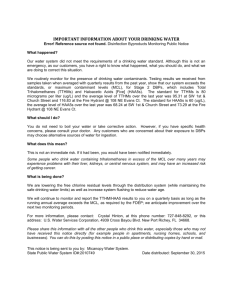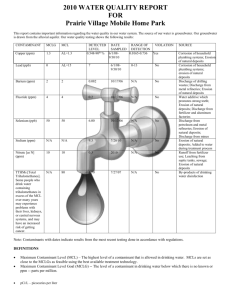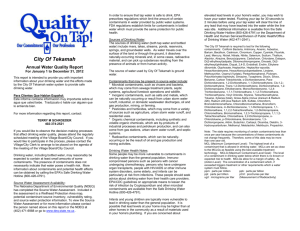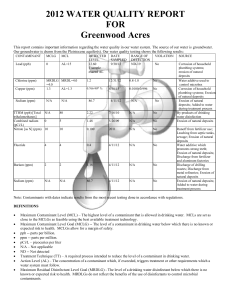CCR-2014 - Lake Elizabeth Mutual Water Co.
advertisement
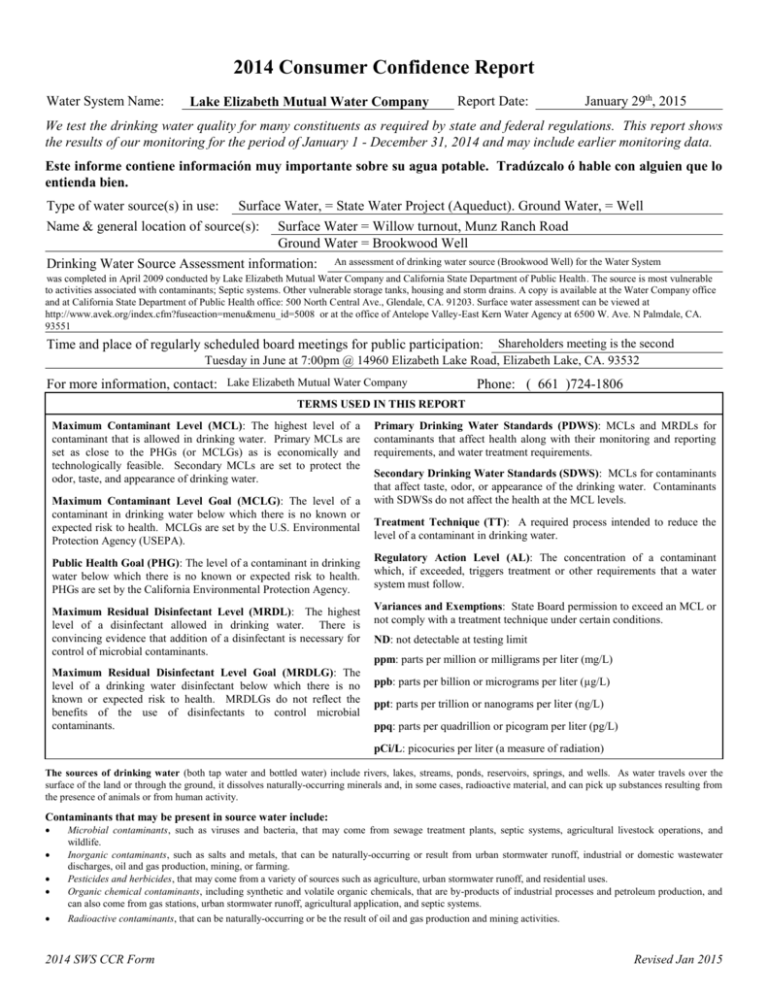
2014 Consumer Confidence Report Water System Name: Lake Elizabeth Mutual Water Company Report Date: January 29th, 2015 We test the drinking water quality for many constituents as required by state and federal regulations. This report shows the results of our monitoring for the period of January 1 - December 31, 2014 and may include earlier monitoring data. Este informe contiene información muy importante sobre su agua potable. Tradúzcalo ó hable con alguien que lo entienda bien. Type of water source(s) in use: Surface Water, = State Water Project (Aqueduct). Ground Water, = Well Name & general location of source(s): Surface Water = Willow turnout, Munz Ranch Road Ground Water = Brookwood Well Drinking Water Source Assessment information: An assessment of drinking water source (Brookwood Well) for the Water System was completed in April 2009 conducted by Lake Elizabeth Mutual Water Company and California State Department of Public Health. The source is most vulnerable to activities associated with contaminants; Septic systems. Other vulnerable storage tanks, housing and storm drains. A copy is available at the Water Company office and at California State Department of Public Health office: 500 North Central Ave., Glendale, CA. 91203. Surface water assessment can be viewed at http://www.avek.org/index.cfm?fuseaction=menu&menu_id=5008 or at the office of Antelope Valley-East Kern Water Agency at 6500 W. Ave. N Palmdale, CA. 93551 Shareholders meeting is the second Tuesday in June at 7:00pm @ 14960 Elizabeth Lake Road, Elizabeth Lake, CA. 93532 Time and place of regularly scheduled board meetings for public participation: For more information, contact: Lake Elizabeth Mutual Water Company Phone: ( 661 )724-1806 TERMS USED IN THIS REPORT Maximum Contaminant Level (MCL): The highest level of a contaminant that is allowed in drinking water. Primary MCLs are set as close to the PHGs (or MCLGs) as is economically and technologically feasible. Secondary MCLs are set to protect the odor, taste, and appearance of drinking water. Maximum Contaminant Level Goal (MCLG): The level of a contaminant in drinking water below which there is no known or expected risk to health. MCLGs are set by the U.S. Environmental Protection Agency (USEPA). Primary Drinking Water Standards (PDWS): MCLs and MRDLs for contaminants that affect health along with their monitoring and reporting requirements, and water treatment requirements. Secondary Drinking Water Standards (SDWS): MCLs for contaminants that affect taste, odor, or appearance of the drinking water. Contaminants with SDWSs do not affect the health at the MCL levels. Treatment Technique (TT): A required process intended to reduce the level of a contaminant in drinking water. Public Health Goal (PHG): The level of a contaminant in drinking water below which there is no known or expected risk to health. PHGs are set by the California Environmental Protection Agency. Regulatory Action Level (AL): The concentration of a contaminant which, if exceeded, triggers treatment or other requirements that a water system must follow. Maximum Residual Disinfectant Level (MRDL): The highest level of a disinfectant allowed in drinking water. There is convincing evidence that addition of a disinfectant is necessary for control of microbial contaminants. Variances and Exemptions: State Board permission to exceed an MCL or not comply with a treatment technique under certain conditions. Maximum Residual Disinfectant Level Goal (MRDLG): The level of a drinking water disinfectant below which there is no known or expected risk to health. MRDLGs do not reflect the benefits of the use of disinfectants to control microbial contaminants. ND: not detectable at testing limit ppm: parts per million or milligrams per liter (mg/L) ppb: parts per billion or micrograms per liter (µg/L) ppt: parts per trillion or nanograms per liter (ng/L) ppq: parts per quadrillion or picogram per liter (pg/L) pCi/L: picocuries per liter (a measure of radiation) The sources of drinking water (both tap water and bottled water) include rivers, lakes, streams, ponds, reservoirs, springs, and wells. As water travels over the surface of the land or through the ground, it dissolves naturally-occurring minerals and, in some cases, radioactive material, and can pick up substances resulting from the presence of animals or from human activity. Contaminants that may be present in source water include: Microbial contaminants, such as viruses and bacteria, that may come from sewage treatment plants, septic systems, agricultural livestock operations, and wildlife. Inorganic contaminants, such as salts and metals, that can be naturally-occurring or result from urban stormwater runoff, industrial or domestic wastewater discharges, oil and gas production, mining, or farming. Pesticides and herbicides, that may come from a variety of sources such as agriculture, urban stormwater runoff, and residential uses. Organic chemical contaminants, including synthetic and volatile organic chemicals, that are by-products of industrial processes and petroleum production, and can also come from gas stations, urban stormwater runoff, agricultural application, and septic systems. Radioactive contaminants, that can be naturally-occurring or be the result of oil and gas production and mining activities. 2014 SWS CCR Form Revised Jan 2015 Consumer Confidence Report Page 2 of 6 In order to ensure that tap water is safe to drink, the USEPA and the State Water Resources Control Board (State Board) prescribe regulations that limit the amount of certain contaminants in water provided by public water systems. State Board regulations also establish limits for contaminants in bottled water that provide the same protection for public health. Tables 1, 2, 3, 4, 5, 7, and 8 list all of the drinking water contaminants that were detected during the most recent sampling for the constituent. The presence of these contaminants in the water does not necessarily indicate that the water poses a health risk. The State Board allows us to monitor for certain contaminants less than once per year because the concentrations of these contaminants do not change frequently. Some of the data, though representative of the water quality, are more than one year old. TABLE 1 – SAMPLING RESULTS SHOWING THE DETECTION OF COLIFORM BACTERIA Microbiological Contaminants Highest No. of Detections No. of months in violation (In a mo.) 0 0 MCL MCLG Typical Source of Bacteria (complete if bacteria detected) Total Coliform Bacteria More than 1 sample in a month with a detection 0 Naturally present in the environment Health Effect Language Coliforms are bacteria that are naturally present in the environment and are used as an indicator that other, potentially-harmful, bacteria may be present. Coliforms were found in more samples than allowed and this was a warning of potential problems. A routine sample and a Fecal Coliform or E. coli (In the year) 0 0 Human and animal fecal waste repeat sample detect total 0 coliform and either sample also detects fecal coliform or E. coli Heath Effect Language Fecal coliforms and E. coli are bacteria whose presence indicates that the water may be contaminated with human or animal wastes. Microbes in these wastes can cause short-term effects, such as diarrhea, cramps, nausea, headaches, or other symptoms. They may pose a special health risk for infants, young children, some of the elderly, and people with severely compromised immune systems. TABLE 2 – SAMPLING RESULTS SHOWING THE DETECTION OF LEAD AND COPPER Lead and Copper (complete if lead or copper detected in the last sample set) Lead (ppb) 7/19/2012 (Tri-Annual) Sample Date 7/19/2012 No. of 90th samples percentile collected level detected 1.3 10 No. sites exceeding AL AL PHG Typical Source of Contaminant 0 15 0.2 Internal corrosion of household water plumbing systems; discharges from industrial manufacturers; erosion of natural deposits Lead: Health Effects Language Lead-Specific Language for Community Water Systems: If present, elevated levels of lead can cause serious health problems, especially for pregnant women and young children. Lead in drinking water is primarily from materials and components associated with service lines and home plumbing. Lake Elizabeth Mutual Water Company is responsible for providing high quality drinking water, but cannot control the variety of materials used in plumbing components. When your water has been sitting for several hours, you can minimize the potential for lead exposure by flushing your tap for 30 seconds to 2 minutes before using water for drinking or cooking. If you are concerned about lead in your water, you may wish to have your water tested. Information on lead in drinking water, testing methods, and steps you can take to minimize exposure is available from the Safe Drinking Water Hotline or at http://www.epa.gov/safewater/lead. Internal corrosion of household Copper (ppm) plumbing systems; erosion of natural 7/19/2012 (Tri-Annual) 7/19/2012 10 0.40 0 1.3 0.3 deposits; leaching from wood preservatives Copper: Health Effects Language Copper is an essential nutrient, but some people who drink water containing copper in excess of the action level over a relatively short amount of time may experience gastrointestinal distress. Some people who drink water containing copper in excess of the action level over many years may suffer liver or kidney damage. People with Wilson’s Disease should consult their personal doctor. TABLE 3 – SAMPLING RESULTS FOR SODIUM AND HARDNESS Chemical or Constituent (and reporting units) Sodium (ppm) Surface water Ground water Sample Date Level Detected Range of Detections 10/23/14 3/11/14 78 61 1 1 Hardness (ppm) Surface water Ground water 10/23/14 3/11/14 105 445 2.5 2.5 MCL PHG (MCLG) Typical Source of Contaminant none none Salt present in the water and is generally naturally occurring none none Sum of polyvalent cations present in the water, generally magnesium and calcium, and are usually naturally occurring *Any violation of an MCL or AL is asterisked. Additional information regarding the violation is provided later in this report. 2014 SWS CCR Form Revised Jan 2015 Consumer Confidence Report Page 3 of 6 TABLE 4 – DETECTION OF CONTAMINANTS WITH A PRIMARY DRINKING WATER STANDARD Chemical or Constituent (and reporting units) Aluminum (µg/L) Surface water Ground water Arsenic (µg/L) Surface water Ground water Barium (µg/L) Surface water Ground water Sample Date Level Detected Range of Detections MCL [MRDL] 10/23/14 3/11/14 310 ND 10 10 1000 1000 10/23/14 3/11/14 7 ND 2 2 10 10 Erosion of natural deposits; runoff from orchards; glass and electronics production wastes 10/23/14 3/11/14 34.2 102 .2 .2 1000 1000 Discharge of oil drilling wastes and from metal refineries; erosion of natural deposits Chromium (µg/L ) (Total CR) Surface water Ground water Fluoride (µg/L) Surface water Ground water Nickel (µg/L) Surface water Ground water Nitrate (NO3)(mg/L) Surface water Ground water Perchlorate (µg/L) Surface water Ground water 2014 SWS CCR Form 10/23/14 3/11/14 1 2 1 1 50 50 10/23/14 3/11/14 ND .4 .1 .1 2 2 10/23/14 3/11/14 ND ND 1 1 100 100 10/23/14 3/11/14 4.7 11.7 .4 .4 45 45 10/23/14 3/11/14 ND ND 2 2 6 6 Typical Source of Contaminant Erosion of natural deposits; residue from some surface water treatment processes Discharge from steel and pulp mills and chrome plating; erosion of natural deposits Erosion of natural deposits; water additive which promotes strong teeth; discharge from fertilizer and aluminum factories Erosion of natural deposits; discharge from metal factories Runoff and leaching from fertilizer use; leaching from septic tanks and sewage; erosion of natural deposits Perchlorate is an inorganic chemical used in solid rocket propellant, fireworks, explosives, flares, matches, and a variety of industries. It usually gets into drinking water as a result of environmental contamination from historic aerospace or other industrial operations that used or use, store, or dispose of perchlorate and its salts. Health Effect Language Some people who drink water containing aluminum in excess of the MCL over many years may experience short-term gastrointestinal tract effects. Some people who drink water containing arsenic in excess of the MCL over many years may experience skin damage or circulatory system problems, and may have an increased risk of getting cancer. Some people who drink water containing barium in excess of the MCL over many years may experience an increase in blood pressure. Some people who use water containing chromium in excess of the MCL over many years may experience allergic dermatitis. Some people who drink water containing fluoride in excess of the federal MCL of 4 mg/L over many years may get bone disease, including pain and tenderness of the bones. Children who drink water containing fluoride in excess of the state MCL of 2 mg/L may get mottled teeth. Some people who drink water containing nickel in excess of the MCL over many years may experience liver and heart effects. Infants below the age of six months who drink water containing nitrate in excess of the MCL may quickly become seriously ill and, if untreated, may die because high nitrate levels can interfere with the capacity of the infant’s blood to carry oxygen. Symptoms include shortness of breath and blueness of the skin. High nitrate levels may also affect the oxygen-carrying ability of the blood of pregnant women. Perchlorate has been shown to interfere with uptake of iodide by the thyroid gland, and to thereby reduce the production of thyroid hormones, leading to adverse affects associated with inadequate hormone levels. Thyroid hormones are needed for normal prenatal growth and development of the fetus, as well as for normal growth and development in the infant and child. In adults, thyroid hormones are needed for normal metabolism and mental function. Revised Jan 2015 Consumer Confidence Report Page 4 of 6 TABLE 5 – DETECTION OF CONTAMINANTS WITH A SECONDARY DRINKING WATER STANDARD Chemical or Constituent (and reporting units) Chloride (CI) (mg/L) Surface water Ground water Color (Unfiltered)( µg/L) Surface water Ground water Copper (µg/L) Surface water Ground water Iron (µg/L) Surface water Ground water Manganese (µg/L) Surface water Ground water Silver (µg/L) Surface water Ground water Sulfate (SO4) (mg/L) Surface water Ground water Zinc (mg/L) Surface water Ground water Sample Date Level Detected Range of Detections 10/23/14 3/11/14 83 95 .4 .4 10/23/14 3/11/14 ND ND 5 5 MCL Typical Source of Contaminant Health Effect Language Runoff/leaching from natural deposits; seawater influence. Naturally occurring organic material. 10/23/14 3/11/14 ND ND 10 10 1000 1000 10/23/14 3/11/14 50 80 50 50 300 300 Internal corrosion of household plumbing systems; erosion of natural deposits; leaching from wood preservatives Short-term exposure: Gastrointestinal distress. Long-term exposure: Liver or kidney damage. People with Wilson’s Disease should consult their personal doctor if the amount of copper in water exceeds the action level Leaching of natural deposits, industrial discharge. Erosion of natural deposits 10/23/14 3/11/14 10 ND 10 10 50 50 10/23/14 3/11/14 ND ND 1 1 100 100 10/23/14 3/11/14 75 122 2 2 Runoff / Corrosion of natural deposits, industrial wastes 10/23/14 3/11/14 ND ND 20 20 Runoff/leaching for natural deposits; industrial wastes The notification level for manganese is used to protect consumers from neurological effects. High levels of manganese in people have been shown to result in effects of the nervous system Industrial discharges. TABLE 6 – DETECTION OF UNREGULATED CONTAMINANTS Chemical or Constituent (and reporting units) Calcium (Ca) (mg/L) Surface water Ground water Magnesium (Mg)(mg/L) Surface water Ground water Potassium (K) (mg/L) Surface water Ground water Sample Date Level Detected Range of Detections 10/23/14 3/11/14 34 96 1 1 10/23/14 3/11/14 5 50 1 1 10/23/14 3/11/14 2 3 1 1 Notification Level Health Effects Language *Any violation of an MCL, MRDL, or TT is asterisked. Additional information regarding the violation is provided later in this report. Additional General Information on Drinking Water Drinking water, including bottled water, may reasonably be expected to contain at least small amounts of some contaminants. The presence of contaminants does not necessarily indicate that the water poses a health risk. More information about contaminants and potential health effects can be obtained by calling the USEPA’s Safe Drinking Water Hotline (1-800-426-4791). Some people may be more vulnerable to contaminants in drinking water than the general population. Immuno-compromised persons such as persons with cancer undergoing chemotherapy, persons who have undergone organ transplants, people with HIV/AIDS or other immune system disorders, some elderly, and infants can be particularly at risk from infections. These people should seek advice about drinking water from their health care providers. USEPA/Centers for Disease Control (CDC) guidelines on appropriate means to lessen the risk of infection by Cryptosporidium and other microbial contaminants are available from the Safe Drinking Water Hotline (1-800-426-4791). Lead-Specific Language for Community Water Systems: If present, elevated levels of lead can cause serious health problems, especially for pregnant women and young children. Lead in drinking water is primarily from materials and components associated with service lines and home plumbing. [INSERT NAME OF UTILITY] is responsible for providing high quality drinking water, but cannot control the variety of materials used in plumbing components. When your water has been sitting for several hours, you can minimize the potential for lead exposure by flushing your tap for 30 seconds to 2 minutes before using water for drinking or cooking. If you are concerned about lead in your water, you may wish to have your water 2014 SWS CCR Form Revised Jan 2015 Consumer Confidence Report Page 5 of 6 tested. Information on lead in drinking water, testing methods, and steps you can take to minimize exposure is available from the Safe Drinking Water Hotline or at http://www.epa.gov/safewater/lead. Summary Information for Violation of a MCL, MRDL, AL, TT, or Monitoring and Reporting Requirement VIOLATION OF A MCL, MRDL, AL, TT, OR MONITORING AND REPORTING REQUIREMENT Violation Explanation Actions Taken to Correct the Violation Duration Health Effects Language NONE For Water Systems Providing Ground Water as a Source of Drinking Water TABLE 7 – SAMPLING RESULTS SHOWING FECAL INDICATOR-POSITIVE GROUND WATER SOURCE SAMPLES Microbiological Contaminants (complete if fecal-indicator detected) E. coli Total No. of Detections Sample Dates MCL [MRDL] PHG (MCLG) [MRDLG] (In the year) 0 Monthly 0 (0) Typical Source of Contaminant Human and animal fecal waste Summary Information for Fecal Indicator-Positive Ground Water Source Samples, Uncorrected Significant Deficiencies, or Ground Water TT SPECIAL NOTICE OF FECAL INDICATOR-POSITIVE GROUND WATER SOURCE SAMPLE NONE SPECIAL NOTICE FOR UNCORRECTED SIGNIFICANT DEFICIENCIES NONE VIOLATION OF GROUND WATER TT TT Violation Explanation Duration Actions Taken to Correct the Violation Health Effects Language NONE For Systems Providing Surface Water as a Source of Drinking Water TABLE 8 - SAMPLING RESULTS SHOWING TREATMENT OF SURFACE WATER SOURCES Treatment Technique (a) (Type of approved filtration technology used) Turbidity of the filtered water must: (b) Turbidity Performance Standards (that must be met through the water treatment process) 1 – Be less than or equal to .3 NTU in 95% of measurements in a month. 2 – Not exceed 1.0 NTU for more than eight consecutive hours. 3 – Not exceed 5.0 NTU at any time. Lowest monthly percentage of samples that met Turbidity Performance Standard No. 1. 99.9% Highest single turbidity measurement during the year .23 NTU Number of violations of any surface water treatment requirements (0) NONE (a) A required process intended to reduce the level of a contaminant in drinking water. 2014 SWS CCR Form Revised Jan 2015 Consumer Confidence Report Page 6 of 6 (b) Turbidity (measured in NTU) is a measurement of the cloudiness of water and is a good indicator of water quality and filtration performance. Turbidity results which meet performance standards are considered to be in compliance with filtration requirements. * Any violation of a TT is marked with an asterisk. Additional information regarding the violation is provided below. Summary Information for Violation of a Surface Water TT VIOLATION OF A SURFACE WATER TT TT Violation Explanation Duration Actions Taken to Correct the Violation Health Effects Language NONE Summary Information for Operating Under a Variance or Exemption NONE DISINFECTION RESIDUAL, PRECURSORS, and BYPRODUCTS Type of Sample(s) Distribution Treated Water Parameter Units Chlorine (as total CL2) mg/L mg/L Source Water Total Organic Carbon (TOC) mg/L Total Trihalomethanes µg/L Total Haloacetic Acids (5) µg/L Distribution Distribution Total Organic Carbon (TOC) MCL/MRDL/A L 4.0** Treatment Requirement Treatment Requirement 80** 60** MRDLG 4.0 RESULTS Range / Average 0.86 - 1.30 / 1.08 0.66 – 2.24 / 1.1 0.99 – 3.4 / 1.8 21.6 – 90.1 / 49.225# ND – 22 / 9# ** Running Annual Average of distribution system samples. The MCLs are based upon Running Annual Averages. # This average is a system-wide value. Contaminant TTHMs (Total Trihalomethanes) Haloacetic Acids 2014 SWS CCR Form Typical Source of Contaminant By-product of drinking water disinfection Byproduct of drinking water disinfection Health Effects Language Some people who drink water containing trihalomethanes in excess of the MCL over many years may experience liver, kidney, or central nervous system problems, and may have an increased risk of getting cancer. Some people who drink water containing haloacetic acids in excess of the MCL over many years may have an increased risk of getting cancer. Revised Jan 2015

